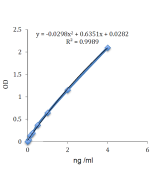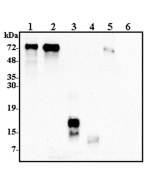Cookie Policy: This site uses cookies to improve your experience. You can find out more about our use of cookies in our Privacy Policy. By continuing to browse this site you agree to our use of cookies.
AdipoGen Life Sciences
Sortilin (human) (rec.) (His)

Method: Progranulin (human) (rec.) (untagged) (Prod. No. AG-40A-0188Y) is coated on an ELISA plate at 1 μg/ml overnight at 4°C. Sortilin (human) (rec.) (His) (Prod. No. AG-40B-0229) or a control His tagged protein (Prod. No. AG-40B-0177) is added (starting at a concentration of 100nM with a twofold serial dilution) during one hour at RT and the interaction is then detected using an anti-His antibody coupled to HRP.
| Product Details | |
|---|---|
| Synonyms | 100 kDa NT Receptor; Glycoprotein 95; Gp95; Neurotensin Receptor 3 ; NT3; NTR3 |
| Product Type | Protein |
| Properties | |
| Source/Host | HEK 293 cells. Produced using animal component-free medium. |
| Sequence |
Human sortilin (aa 78-755) is fused at the C-terminus to a His-tag. |
| Crossreactivity | Human |
| Biological Activity |
Binds to human Progranulin (untagged) (Prod. No. AG-40A-0188Y). Binds only weakly to Progranulin with a Flag Tag at the C-terminus (Prod. No. AG-40A-068Y). |
| MW | ~100kDa (SDS-PAGE) |
| Purity | ≥95% (SDS-PAGE) |
| Endotoxin Content | <0.01EU/μg purified protein (LAL test). |
| Concentration | 1mg/ml after reconstitution. |
| Reconstitution | Reconstitute with 50µl endotoxin-free water. |
| Accession Number | Q99523 |
| Formulation | Lyophilized. Contains PBS. |
| Other Product Data |
UniProt link Q99523: Sortilin (human) Protein |
| Shipping and Handling | |
| Shipping | BLUE ICE |
| Short Term Storage | +4°C |
| Long Term Storage | -20°C |
| Handling Advice |
After opening, prepare aliquots and store at -20°C. Avoid freeze/thaw cycles. Centrifuge lyophilized vial before opening and reconstitution. |
| Use/Stability |
Stable for at least 6 months after receipt when stored at -20°C. Working aliquots are stable for up to 3 months when stored at -20°C. |
| Documents | |
| MSDS |
 Download PDF Download PDF |
| Product Specification Sheet | |
| Datasheet |
 Download PDF Download PDF |
Sortilin is a type I transmembrane multiligand receptor that is a member of the Vacuolar protein sorting 10 protein (Vps10p) domain receptor family. It is a 95 kDa protein, ubiquitously expressed, although most abundantly expressed in neurons, hepatocytes, adipocytes and white blood cells including macrophages. Sortilin is synthesized as a propeptide in the endoplasmic reticulum (ER) and processed to its mature form by furin-mediated cleavage in the trans-Golgi network.
The primary function of sortilin is trafficking proteins from the Golgi to secretory vesicles and endolysosomal compartments. The majority of trafficking is from the Golgi to the endosomal compartment where sortilin deposits cargo targeted for catabolism in the lysosome and then is trafficked back to the Golgi via a retromer complex. At the cell surface, sortilin can remain intact and act as a receptor for extracellular ligands that can initiate signaling cascades or be internalized as a method of receptor-mediated endocytosis. Additionally, cell surface sortilin protein can undergo an additional cleavage that results in the release of the soluble form of the protein into the extracellular space.
The sortilin receptor binds the nerve growth factor precursor (proNGF), neurotensin and Progranulin (PGRN), a secreted growth factor implicated in a multitude of processes ranging from regulation of inflammation to wound healing, tumorigenesis and neurological diseases. Sortilin controls PGRN trafficking (endocytosis) and is indirectly involved in lysosomal degradation of PGRN. Sortilin down-regulation via blocking antibodies is a key mechanism in increasing extracellular PGRN levels suggesting that sortilin is a potential target to correct PGRN reduction, such as that in patients with frontotemporal dementia (FTD) caused by GRN mutations.









